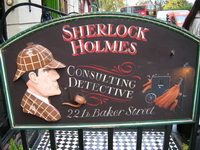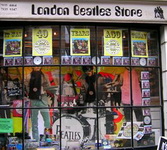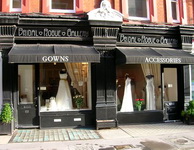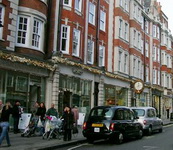Dave the Taxi Driver's
|
| |
|
Dave the Taxi Driver's | |
|
|
|
 |
 |
 |
 |
||||||||||||||||||||||||||||||||
Marylebone (W1/NW1)
Towards the end of the last century, occasionally in the course of my work, I used to take a lady named Jill from Fulham to a famous TV station. I need not mention the name of the station, but its initials are b, b & c. Now Jill confided in me that one of her ambitions was that at some time she would like to get married. When I told her that I was sorry but I was already married she replied ďNo thanks! Iím not that desperateĒ. I like a woman with spirit, even though I considered her judgement might be suspect. Another ambition was that she said she would like to become, in her later life, a Ďblue rinse ladyí living in Marylebone. She omitted to say what she intended to do with her husband, assuming that she would have acquired one in the meantime. Up until then I had not been aware of Maryleboneís reputation. That of it being the location of ageing spinsters or maybe widows, who would have spent the evenings of their lives there before moving on to pastures new, maybe into a comfortable retirement home in Berkshire. I am told that with more and more professionals looking for city centre properties, that many of the blue rinse ladies have cashed in and gradually moved away into the country. The spinsters have become bachelorettes. Maybe the era of the blue rinse lady is coming to an end. The Ďvillageí of Marylebone is centred on Marylebone High Street and Marylebone Lane, two streets which are squeezed in between the constantly traffic busy Marylebone Road and Oxford Street. Marylebone possesses an air of respectability which complements its feel of a bustling country town quite separate from the West End shopping which is just down the road. Just pretend that the rest of London does not exist and you could be anywhere in the Home Counties. On a Saturday there is a silence in the adjacent streets to the west of the high street that is a world away from Oxford Street or Soho. Quiet residential streets of large red mansion blocks with dark windows. On the ground floor, discreet, elegant shops offer tasteful evening wear for ladies, or a polite hairdressing appointment, followed by a coffee under an awning on a sunlit afternoon. The area possesses impressive Georgian and Regency Squares, grey stone apartments with classical proportions and large terraces of Georgian and Regency houses which include the Portman and De Walden Estates. In between are the ubiquitous mews houses, the stitches in the backcloth of residential Central London. Maryleboneís boundaries stretch from the Marble Arch at the foot of Edgware Road, to the north of Marylebone Road and the boundary with St. Johnís Wood(NW8) the southern limit being Oxford Street. Formerly known as Marylebone Park, the beautiful expanse of Regentís Park begins at York Gate on the north side Marylebone Road with further access from Marylebone at Clarence Gate, Hanover Gate and Park Square West. The eastern edge of Marylebone seems to have gradually moved westwards. The City of Westminster north of Oxford Street extends eastwards almost to Tottenham Court Road to the boundary of the London Borough of Camden and therefore was the eastern part of Marylebone. It was here in the 1930s that the bohemians and journalists who frequented the Fitzroy Tavern chose the appellation of Fitrovia for the area. The name has been accepted by the residents as a separate identity. The boundary has therefore crept westwards to Regent Street/Langham Place/Portland Place. The abode of world renowned surgeons and private medical clinics Harley Street, although so famous in its own right, is a generic name for the medical area which comprises all the streets around here. To the north of Marylebone Road close to Regentís Park are more mansion blocks. Marylebone Railway Station (Chiltern Railways) and Tube Station (Bakerloo Line) are in Melcombe Place.
|
Major hotels in the area include the Cumberland by Marble Arch; the Churchill and Radisson SAS in Portman Square; Clifton Ford, Welbeck Street; Marriott, George Street; the Landmark opposite Marylebone Station in Melcombe Place; Sherlock Holmes, Baker Street; Durrantís, George Street; Mandeville, Mandeville Place; Selfridge Hotel, Edwards Mews and the lavish Langham Hilton opposite the BBC in Portland Place. In the middle of Portland Place is the memorial to philanthropist Quintin Hogg, founder of the Young Menís Christian Institute which later became Regent Street Polytechnic. The original Lordís Cricket Ground, opened by Thomas Lord in 1787, occupied the site of Dorset Square by the northern end of Gloucester Place. Lordís, the home of Marylebone Cricket Club (MCC) and later Middlesex County Cricket Club, moved to Regentís Park, but because the route of the Regentís Canal was intended to pass through the area, another move became necessary to St. Johnís Wood Road, where the ground has been ever since. Wigmore Hall, the celebrated concert venue is at No. 36 Wigmore Street, close to Cavendish Square and the Wallace Art Collection is at Hertford House, Manchester Square.
|
In the middle of Portland Place is the memorial to philanthropist Quintin Hogg, founder of the Young Menís Christian Institute which later became Regent Street Polytechnic. The original Lordís Cricket Ground, opened by Thomas Lord in 1787, occupied the site of Dorset Square by the northern end of Gloucester Place. Lordís, the home of Marylebone Cricket Club (MCC) and later Middlesex County Cricket Club, moved to Regentís Park, but because the route of the Regentís Canal was intended to pass through the area, another move became necessary to St. Johnís Wood Road, where the ground has been ever since. Wigmore Hall, the celebrated concert venue is at No. 36 Wigmore Street, close to Cavendish Square and the Wallace Art Collection is at Hertford House, Manchester Square.
|
The name Marylebone derives from the church of St. Mary le Bourne which was built around the year 1400 on the bank of the River Tyburn when it flowed through what is now Marylebone Lane. If any part of Marylebone stamped its presence on its history as a place of resort and culture, it was the gardens of Marylebone Manor House which opened in 1650. Marylebone Gardens were to become very fashionable for over one hundred years until they closed in 1778. There used to be an inn called The Rose of Normandy which stood at the northern end of the Marylebone High Street. No. 35 to be exact. The Rose of Normandy which had two bowling greens, became the entrance to the gardens which would have backed onto the land from the Manor. In later times the ĎRoseí became a Music Hall. The building has been occupied for some time by the BBC Radio London. In the pavement outside are set the lights of the Music Hall. Marylebone Manor House, which was built in the early fifteenth century used to stand on the site of modern Devonshire Mews. As with much of the history of London, Henry VIII played a pivotal role. In 1544 the Manor was given to Henry in exchange for lands which had been taken from the church after the Dissolution in1533. Henry converted the Manor House into a hunting lodge. In due course it became a boarding school until it was demolished in 1791.
|
Musical gatherings at Marylebone Gardens were resplendent with high society. Performers included George Frideric Handel, Dr. Samuel Arnold and Sir Thomas Arne, the composer of Rule Britannia. In John Gayís The Beggarís Opera (1728)the hero Macheath frequents Marylebone Gardens. Of course latterly via The Threepenny Opera, Macheath became well known in Bobby Darinís ĎMack the Knifeí. In1738 the gardens were enlarged and further landscaped. An entrance fee of 6d (six pence) was levied in order maintain a higher social clientele or in other words, to keep out the riff raff. One year later assembly rooms were built so that musical concerts and balls could be held there.
|
On 23rd February 1820 in the loft above No.1a Cato Street ,the group of conspirators led by Arthur Thistlewood were surprised by a raid on the premises by a number of Coldstream Guards and Police (then they were known as Bow Street Officers). Thistlewood along with four others were hanged at Newgate Prison The very first London Bus Route began in Marylebone. George Shillibeer, a Frenchman, had already applied to be a proprietor of 35 taxis in London. His application had been refused, maybe because he was French, so he then decided to operate the first bus or Ďomnibusí service as it was then known. At that time only 6-12 people could be accommodated in the vehicles. The route began at the Yorkshire Stingo Tavern on Marylebone Road and ended at Bank. A notorious gathering which took place in Marylebone was the Cato Street Conspiracy. There was a plot was to murder the government Cabinet whilst they were dining at No.44 Grosvenor Square. The conspirators intended to capture Couttís Bank, the cannon in the Artillery Ground and at Grayís Inn, the Mansion House (residence of the Lord Mayor of London) Bank and the Tower of London, the aim being to set up a breakaway government.
|
H.G. Wells lived at Chiltern Court Baker Street between 1930 and 1936. He died at 13 Hanover Terrace NW1 in August 1946.
|
Hotels In MaryleboneIn Marylebone, you will never be far from the West End shopping. You are also close to two of Londonís beautiful parks. If you like to take a stroll or a jog in the morning, why not choose a hotel near Hyde Park or Regentís Park? There are many, varied hotels in Marylebone. According to your budget, you can take your choice. There are welcoming guest houses, such as the family run Bentinck House Hotel, which is a mansion style Victorian building in genteel Bentinck Street, near Oxford Street. The more modern, four star Thistle Marble Arch overlooks Oxford Street with the three star Best Western Mostyn opposite in Bryanston Street. Really convenient for Lordís Cricket Ground and Regentís Park are the four star, Dorset Square Hotel, in leafy Dorset Square, the London Marriott Hotel Marble Arch in George Street, with its own swimming pool and the deluxe, five star Landmark, with its fabulous eight storey atrium, just opposite Marylebone Station, is a regular winner of the íBest Hotel in Londoní. In Portman Square is the Hyatt Regency London-still known as the Churchill -with its Locanda Locatelli, Michelin starred Italian restaurant. The stylish four star Cumberland, a Guoman hotel by Marble Arch near Hyde Park, hosts a Michelin Star restaurant and brasserie, courtesy of Gary Rhodes. Throughout, there are displays of original artwork. A little further into Great Cumberland Place at the Montcalm, you have five star comfort, with marble bathrooms and a choice of six fragrances for your room. Also in Great Cumberland Place, the two star Rose Court offers modern en suite rooms. A piece of history just around the corner is the friendly, two star Edward Lear in Seymour Street. A character town house hotel, where the poet himself used to live. Or if you would like to stay in a Victorian Heritage House, there is the two star Boston Court in Upper Berkeley Street. For budget economy the Marble Arch Inn is just along the street. Can you stay in Baker Street without becoming involved with Sherlock Holmes? Maybe, maybe not, but the comfortable four star, Park Plaza Sherlock Holmes, with its Sherlockís Grill and gym, is a short walk to Regentís Park and Madame Tussaudís. Also, close by in a lovely old building in tranquil Chiltern Street, the three star Blandford has air conditioned rooms with satellite TV and buffet breakfast included. By busy Marylebone High Street the Regency is a three star b&b offering inclusive traditional English breakfast. In an 18th century building in George Street the four star Durrants is a Marylebone institution. Elegant dining and only doors away from the Wallace Collection in Manchester Square. If you prefer a more private stay, you can book the three star Access Apartments in Harrowby Street, close to the Victoria Casino and lots of Middle Eastern restaurants. The 146 Suites are near the top of Gloucester Place, nearer to Regentís Park. Tube: Marylebone ( National Rail), Baker Street, Regentís Park, Great Portland Street, Oxford Circus, Bond Street, Marble Arch, Edgware Road Any questions? E-mail me For tours, transfers and other taxi services see Dave's Taxi Page
|
| |||||||||||||||||||||||||||